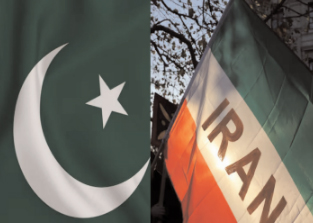
Kickerline: Tangled and multi-layered geopolitics of West Asia has entered the South Asian strategic calculus
It may be inferred that both Iran and Pakistan have acted to establish the credibility of their deterrence posture. However, given the shadowy nature of terror-related intelligence inputs and the identity of the main state actors behind proxy groups, it is difficult to arrive at an objective and informed assessment on whether the actions by the two states were measured and appropriate, or impulsive.

In a couple of dramatic developments last week, Iran launched air attacks on its nuclear-armed neighbor Pakistan and was subjected to tit-for-tat strikes. Though billed as counter-terrorism operations, the use of missiles and fighter jets raised concerns that the conflict could escalate into a war. However, both nations have now agreed to defuse tensions. On January 19, Pakistan stated that it desired to work with Iran in “the spirit of mutual trust and cooperation” and would strengthen coordination on counter-terrorism.
Whether China will use its leverage in the region to promote stability or discord, driven by Beijing’s penchant to fetter India, remains a moot point.
There is an ironic twist in the way Iran and Pakistan are responding to perceived threats from terror groups across their border, given that both nations have honed the strategy of covert state support to non-state entities engaged in terror activities to advance their geopolitical objectives. The Iran-Pakistan border areas are largely inhabited by a restive Balochi population that has been ruthlessly oppressed by both states to quell separatist aspirations. Over the last few decades, the Shia-Sunni theological divide has fueled terror groups that are also influenced by religious fervor in the extended West Asian region, where the Iran-Saudi geopolitical and socio-religious competition has a long history. Another significant factor is the age-old Arab-versus-Persian ethnic fault lines and Iran’s distinctive strategic identity and aspirations in the Islamic world.
In the current instance, despite the welcome turn of events wherein a potential Iran-Pakistan crisis was averted, it is evident that the tangled and multi-layered geopolitics of West Asia has entered the South Asian strategic calculus and this will pose many challenges to India in the near future. The extended region that encompasses South and West Asia was convulsed in recent decades by the tectonic events of 1979 — the overthrowing of the Shah of Iran and the emergence of political Shia-Islam; the Soviet invasion of Afghanistan that brought the Cold War to the region; and the rise of militancy-cum-terrorism symbolized by Kalashnikov-wielding mujahideen driven by religious zealotry.
India felt the negative effects of the 1979 upheaval in the early 1990s. Following the Soviet withdrawal from Afghanistan, a triumphant Pakistan, which had supported the Afghan mujahideen, stepped up its anti-India terror activities and the erstwhile state of Jammu and Kashmir was badly scarred.
More recently, the October 7, 2023, Hamas terror attack on Israel and the disproportionate reprisal that Tel Aviv is prosecuting have had a non-linear consequence that has adversely impacted the world at large. This is manifested in Houthi attacks on global merchant shipping, and once again, a non-state entity with state support (Iran) has posed an intractable challenge to the major powers and the safety of critical SLOCs (sea lines of communication).
Iran’s locus in the larger southern Asian strategic template, Tehran’s nuclear aspirations and anxieties, its deeply ingrained anti-US/anti-Israel orientation and the proximity to both China and Russia will shape the regional strategic framework in the years ahead. This, in turn, will have acute relevance for India, given China’s ambitions related to Beijing’s Belt and Road Initiative (BRI) that has the Xi Jinping imprimatur. Both Iran and Pakistan have critical areas to advance BRI objectives.
Thus, it is instructive that Beijing was seen as the preferred mediator for defusing the current Iran-Pakistan situation, and while there has been no official confirmation, the possibility that China had a quiet role in lowering the bilateral temperatures remains high. Whether China will use its leverage in the region to promote stability or discord, driven by Beijing’s penchant to fetter India, remains a moot point, but it will be a significant element in the affairs of the subcontinent.
Iran’s mid-January counter-terror actions, which included strikes against Iraq, Syria and Pakistan, mark a departure from the norm that Tehran had followed until now. The use of air power and precision-guided weapons could become the new benchmark for such exigencies. While Tehran has claimed that it took action based on intelligence inputs in each case, domestic political compulsions are also significant drivers.
Early in January, a terrorist attack in Kerman, southeast of Tehran, resulted in the death of nearly 100 people at a memorial for Iran’s top commander Qasem Soleimani. Subsequently, the ISIL/ISIS claimed responsibility for this dastardly attack, making it clear that Iran had to take action against ISIS to assuage the anger and grief of its citizens. In the case of Pakistan, the rationale offered by Iran is that it was targeting bases of the Jaish al-Adl, a Sunni Baloch armed group operating from Balochistan (formerly designated as Jundallah) that was involved in a mid-December attack in the Sistan province. The January 16 attack was purportedly carried out to pre-empt another strike.
It may be inferred that both Iran and Pakistan have acted to establish the credibility of their deterrence posture. However, given the shadowy nature of terror-related intelligence inputs and the identity of the main state actors behind proxy groups, it is difficult to arrive at an objective and informed assessment on whether the actions by the two states were measured and appropriate, or impulsive.
Dissuading non-state terror groups through resolute military action can be protracted and costly and yield negative returns, as demonstrated by the US-led ‘global war on terrorism’ in the wake of the 9/11 attacks.
Jittery deterrence holds even greater significance in a troubled region armed with weapons of mass destruction, and the Iran-Pakistan tit-for-tat attacks provide valuable crisis management lessons for regional policymakers.
(The author is Director, Society for Policy Studies)





Be the first to comment